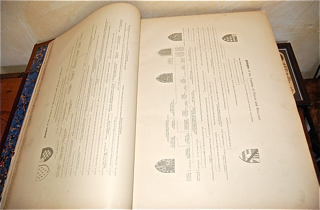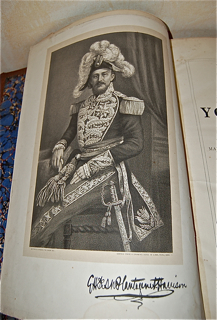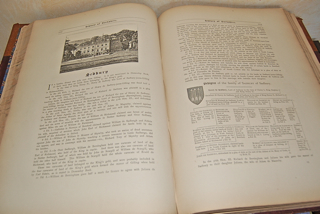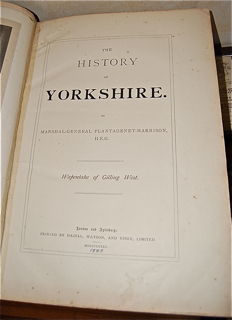Harrison, George Henry [G. H. De S. N. Plantagenet-Harrison]
The History of Yorkshire: Volume I, the Wapentake of Gilling West.
back

|
Seller ID: 1481 London and Aylesbury: the Author, 1885. Second edition, dedicated to Sir Henry De Burgh-Lawson, Bt. (pp. frontis, xiii, [16], 576, index of places, index of names). Large folio (45 cm) in three-quarter brown faux leather cloth over textured maroon cloth, gilt decoration and new gilt title on label, marbled edges; frontis portrait of Harrison in ambassador's uniform (probably Peruvian); fifty-eight views, illustrations, and approximately two hundred pedigrees including, for example, those of Queen Victoria and George Washington. The backstrip at some point replaced with stout but unappealing cloth; frontis was found loosely inserted and is now neatly tipped in (It is a few cm. shorter and may originate with the first edition or may have been trimmed); several minor nicks and chips remain; rear endpaper replaced. George Henry Harrison, the author of�The History of Yorkshire: Volume I,� the Wapentake of Gilling West is reliably reported as having been born in 1817 at Whashton, Kirby Ravensworth, in the North Riding, Yorkshire. He died in 1890. Beyond that, however, there is mostly speculation and, shall we say, invention. Most of it comes from Harrison himself but some of it comes from others who probably should have known better. For example, the National Archives�Catalogue�refers to him as 'General G H de M Plantagenet-Harrison' and inserts a knowing�sic�in square brackets, indicative of the cataloguer's skepticism about the military title. Harrison's real name, it is claimed, was "James Phillippe, a genealogist," who "around 1830... began to research the families of Richmondshire." While it is conceivable that Harrison (or Phillippe) began work on his monumental history of Yorkshire in his early teens (He was thirteen in 1830), it is more likely the cataloguer has condescendingly grasped the wrong end of the stick, for the London�Gazette�(29 October 1867) reports "George Henry De Strabolgie Neville Plantagenet Harrison, carrying on business as a Genealogist and Herald... in the name of James Phillippe" at various addresses in Middlesex has been "adjudged bankrupt." Moreover, there is a record showing a George Henry Harrison, one of six children born to Margaret Hutchison (1787- 1864) and Marley Harrison (1772- 1822) of Whashton, Yorkshire in 1817. 'James Phillippe' almost certainly is the pseudonym and not the other way about. Harrison did little to clarify matters, however, nor was he overly modest in his claims to distinction and accomplishment. At the outset of his�History of Yorkshire, he styles himself� "Prince of Plantagenet- Skioldungr, Duke of Lancaster, Normandy, Aquitaine and Scandinavia, Count of Anjou, Maine, Guienne, Poictou, Earl of Lancaster, Chester, Richmond, and Kent" and so on for the better part of a full page. His military resume includes service as a general officer in Mexico during the war of the Yucatan (1843), with the army of Peru (1844), and in Argentina at Corrientes with General Jose Maria Paz and the Army of God and Liberty (1845); in Europe, in the revolutionary year 1848, Harrison claims to have served as General of Cavalry in the Danish army and, later in the same year, as Lt.- General of the German confederation. He ended his military career in 1853, he says, as a Marshal in the Turkish army.� It's not all that easy to know what to make of Harrison. One commentator in�Notes and Queries�(15 March 1930) simply dismisses him as "a pedigree forger of the worst and most unscrupulous type" and that is hardly surprising given that his own fabulous family pedigree, included in the�History, traces his origins back through history and pre-history to the Norse god Odin. But surely this is fantasy, not forgery. It has about it the comic lunacy of a Monty Python sketch. On the other hand, Nancy McLaughlin,� reviewing Harrison's�History�for genealogy aficionados, seems to accept Harrison's claims to military eminence. She writes, perhaps thinking of her readers, many of whom may have taken to genealogical research in their retirement, "By the 1850's he had evidently concluded a most successful and adventurous army career, and had returned to England to devote himself to the study of genealogy." And it happens that Harrison really was present at Corrientes, Argentina, and did meet with General Paz who remarks in his�Memorias postumas that in the second fighting season at Corrientes he was introduced to the "celebrated English general Plantagenet Harrison" who it was said possessed great wealth and whose support was "worth an army". However, shortly after their first meeting, Paz says, "I suggested a trip to Rio de Janeiro, in order to procure weapons, and used the occasion to get rid of him." General Paz says that it took but a few words from Harrison to convince him the famous English officer was, in a Spanish phrase which needs no translation, "un maldito estupido." There's a good chance, too, that Harrison actually turned up in the Yucatan during the uprising in 1843 and a year or so later in Peru where he commissioned a portrait of himself decked out in the uniform of an ambassador (probably Peruvian), but his part in the South American civil wars and later in revolutionary Europe surely was one meant to be played by Groucho Marx and not George C. Scott. A glance at the ambassadorial portrait which serves as the frontispiece to his�History�seems conclusive.� In the early 1850's Harrison returned to England (triumphantly, he must have thought ), presented himself at the library of the British Museum, and applied for a reader's card in the name of the Duke of Lancaster. Accounts of what happened next differ somewhat.�Modern English Biography�(Boase) states Harrison was "banned" from the library; elsewhere it is suggested he was offered reader's services as plain Mr. Harrison,�pace�the ducal title (or, we won't ask and you won't tell). In any event, Harrison adjourned at once to the Public Records Office as a far more interesting source of raw material and over the next thirty years produced an extraordinary study of land tenure, translating and collating antique documents ("charters, rolls, fines, feoffments, inquisitions post mortem, deeds, books of the Exchequer") long ago squirreled away and lying dormant in the PRO.� Harrison's researches into Yorkshire real estate, amounting to some thirty hand-written volumes, fully indexed, were the source of his projected six volume�History of Yorkshire, only the first of which was completed for publication and is the book offered here. While "questions have been asked" about Harrison's pedigrees, his research into property transfer and ownership, together with tracing the attached families, has apparent merit.�(After his death in 1890, his daughter Blanche offered the complete Ms collection to the PRO which bought a select dozen volumes for few hundred pounds.� In 1892 Blanche Plantagenet-Harrison married John Routh, MA, of Clints House, Gayle, Yorkshire. It was recorded that shortly thereafter, Mr. Routh claimed�"jure matris�[through his mother] the ancient Barony of Swivington, dormant since the reign of Edward III."� It must have been catching.) A clean, sound copy of quite an extraordinary book. Price: $595.00
For more information or to place your order, you can email us at info@trilliumbooks.ca, telephone us at 705-749-0461, |








